TOYOTA TACOMA 2016 Owners Manual (in English)
Manufacturer: TOYOTA, Model Year: 2016, Model line: TACOMA, Model: TOYOTA TACOMA 2016Pages: 640, PDF Size: 40.18 MB
Page 171 of 640
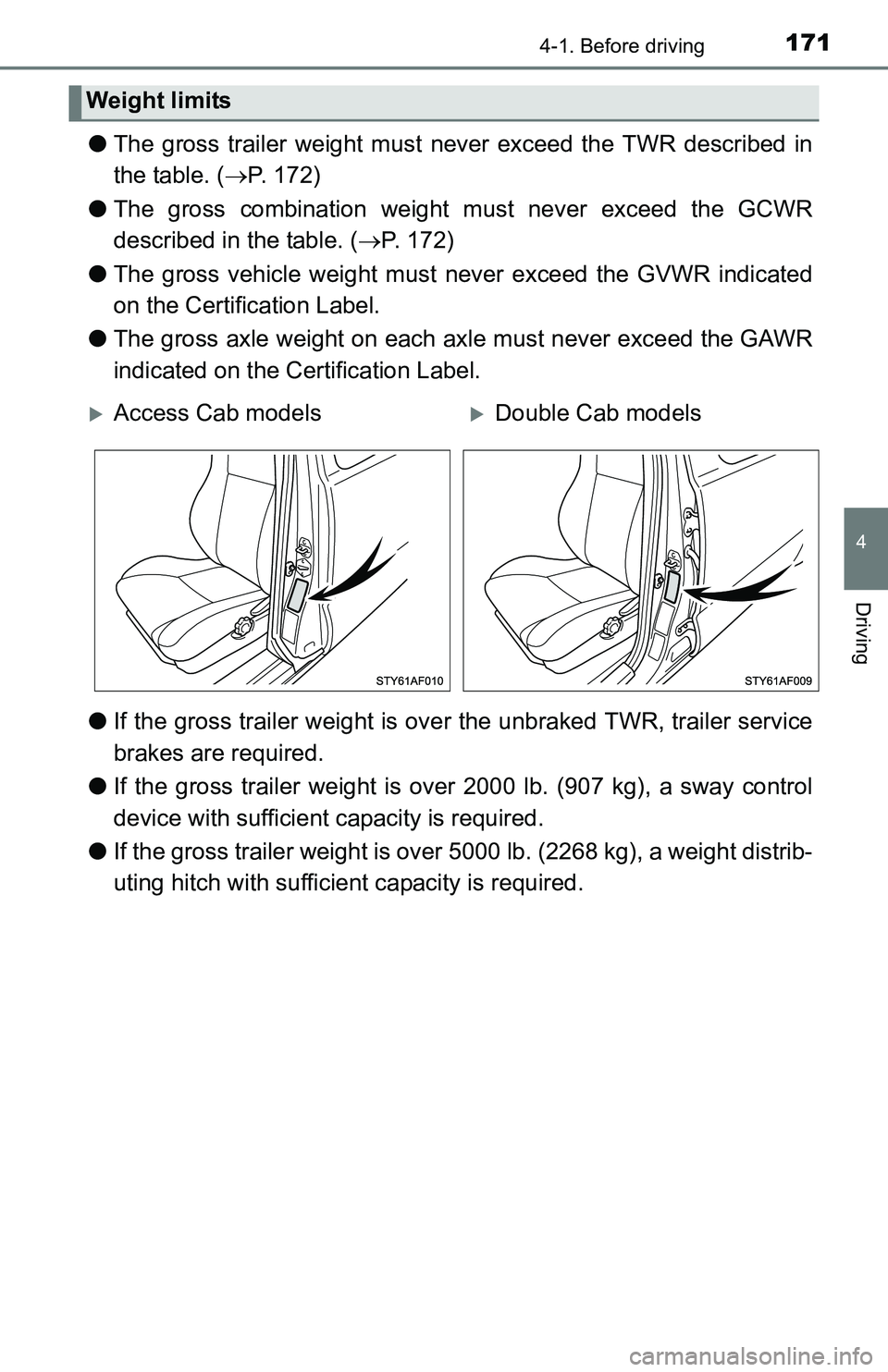
1714-1. Before driving
4
Driving
●The gross trailer weight must never exceed the TWR described in
the table. (P. 172)
●The gross combination weight must never exceed the GCWR
described in the table. (P. 172)
●The gross vehicle weight must never exceed the GVWR indicated
on the Certification Label.
●The gross axle weight on each axle must never exceed the GAWR
indicated on the Certification Label.
●If the gross trailer weight is over the unbraked TWR, trailer service
brakes are required.
●If the gross trailer weight is over 2000 lb. (907 kg), a sway control
device with sufficient capacity is required.
●If the gross trailer weight is over 5000 lb. (2268 kg), a weight distrib-
uting hitch with sufficient capacity is required.
Weight limits
Access Cab modelsDouble Cab models
Page 172 of 640
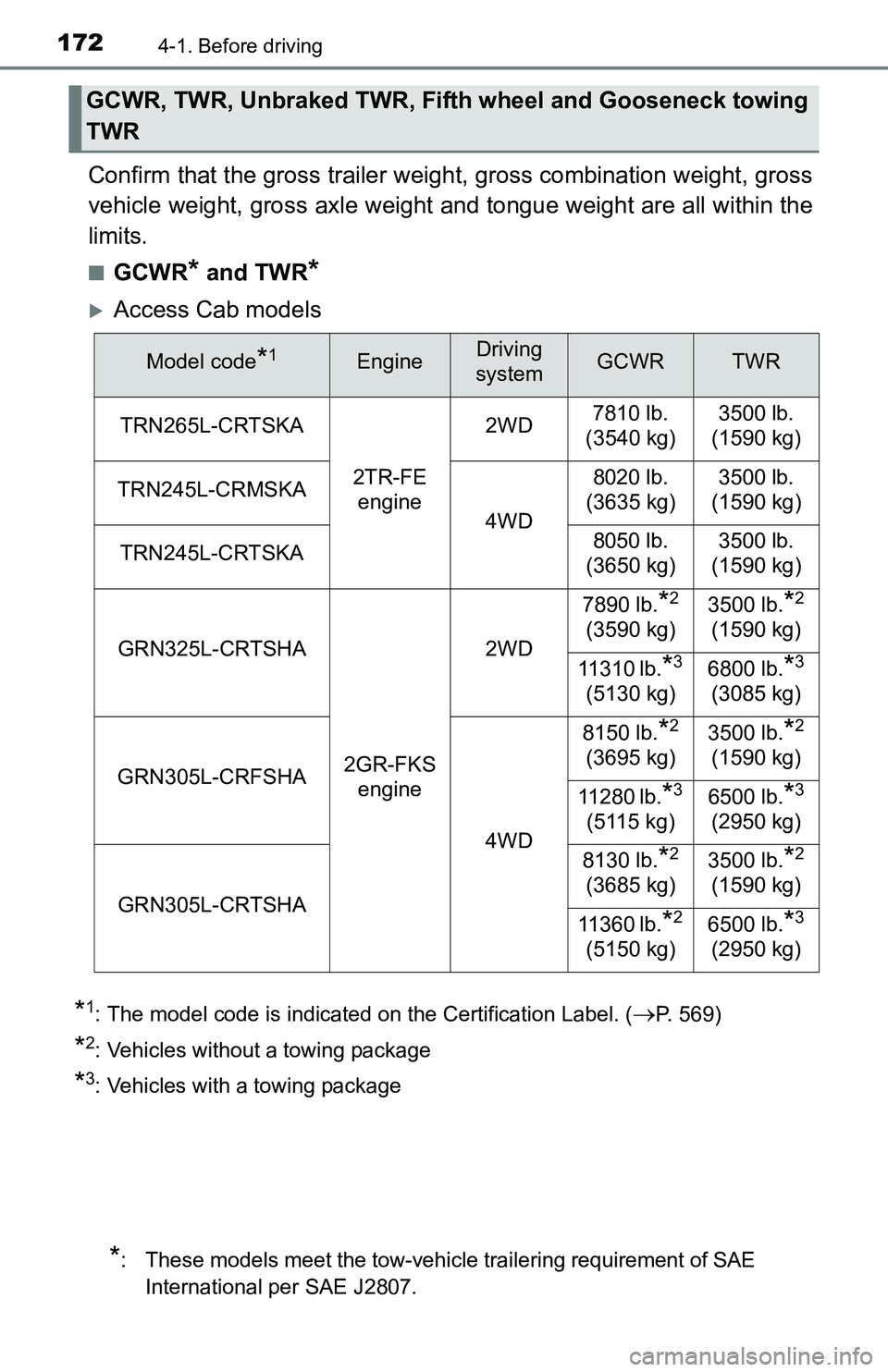
1724-1. Before driving
Confirm that the gross trailer weight, gross combination weight, gross
vehicle weight, gross axle weight and tongue weight are all within the
limits.
■GCWR* and TWR*
Access Cab models
*1: The model code is indicated on the Certification Label. (P. 569)
*2: Vehicles without a towing package
*3: Vehicles with a towing package
GCWR, TWR, Unbraked TWR, Fifth wheel and Gooseneck towing
TWR
*: These models meet the tow-vehicle trailering requirement of SAE
International per SAE J2807.
Model code*1EngineDriving
systemGCWRTWR
TRN265L-CRTSKA
2TR-FE
engine2WD7810 lb.
(3540 kg)3500 lb.
(1590 kg)
TRN245L-CRMSKA
4WD8020 lb.
(3635 kg)3500 lb.
(1590 kg)
TRN245L-CRTSKA8050 lb.
(3650 kg)3500 lb.
(1590 kg)
GRN325L-CRTSHA
2GR-FKS
engine2WD7890 lb.
*2
(3590 kg)3500 lb.*2
(1590 kg)
11310 lb.
*3
(5130 kg)6800 lb.*3
(3085 kg)
GRN305L-CRFSHA
4WD8150 lb.
*2
(3695 kg)3500 lb.*2
(1590 kg)
11280 lb.
*3
(5115 kg)6500 lb.*3
(2950 kg)
GRN305L-CRTSHA8130 lb.
*2
(3685 kg)3500 lb.*2
(1590 kg)
11360 lb.
*2
(5150 kg)6500 lb.*3
(2950 kg)
Page 173 of 640
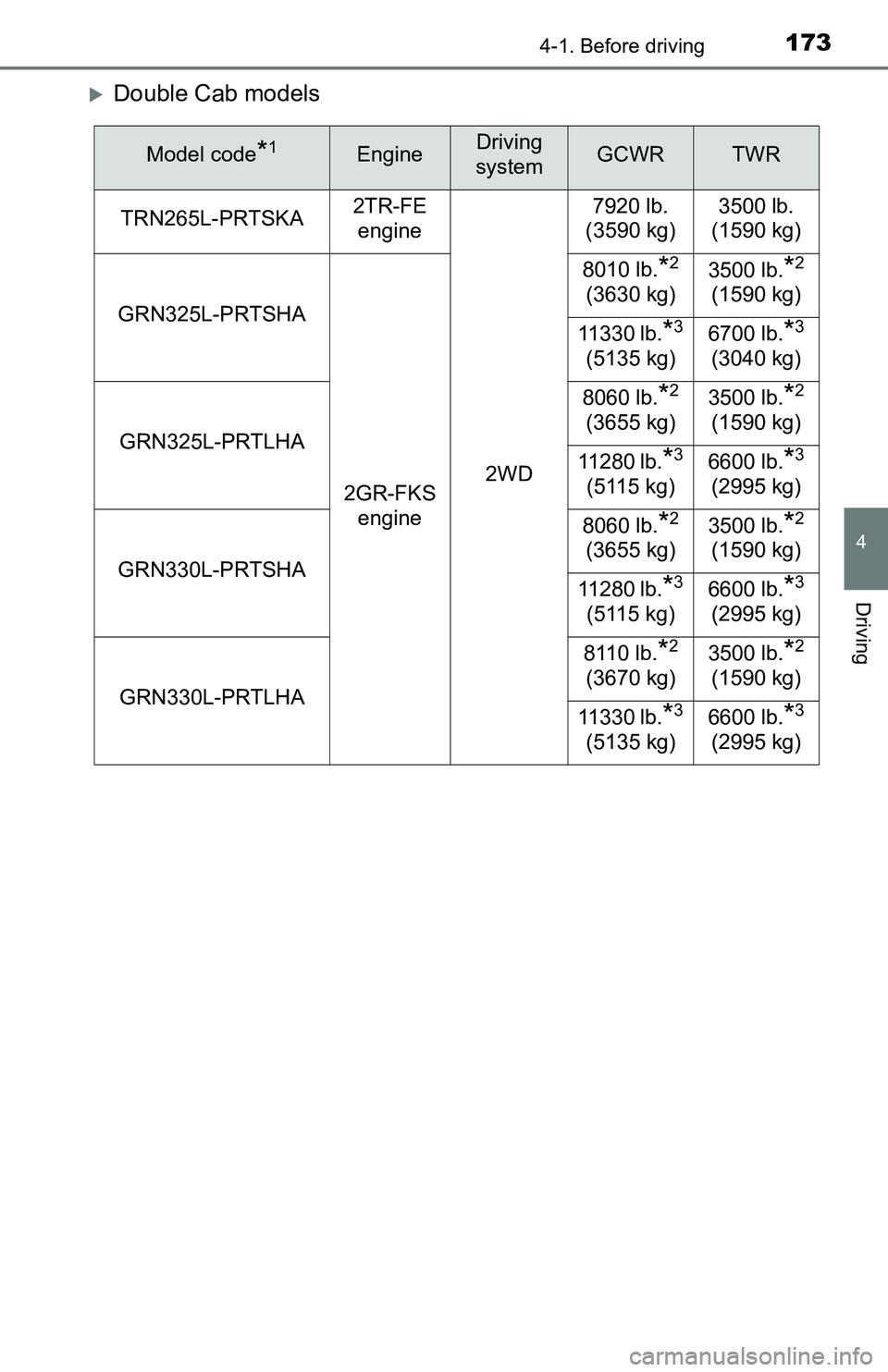
1734-1. Before driving
4
Driving
Double Cab models
Model code*1EngineDriving
systemGCWRTWR
TRN265L-PRTSKA2TR-FE
engine
2WD7920 lb.
(3590 kg)3500 lb.
(1590 kg)
GRN325L-PRTSHA
2GR-FKS
engine8010 lb.
*2
(3630 kg)3500 lb.
*2
(1590 kg)
11330 lb.
*3
(5135 kg)6700 lb.
*3
(3040 kg)
GRN325L-PRTLHA8060 lb.
*2
(3655 kg)3500 lb.
*2
(1590 kg)
11280 lb.
*3
(5115 kg)6600 lb.
*3
(2995 kg)
GRN330L-PRTSHA8060 lb.
*2
(3655 kg)3500 lb.
*2
(1590 kg)
11280 lb.
*3
(5115 kg)6600 lb.
*3
(2995 kg)
GRN330L-PRTLHA8110 lb.
*2
(3670 kg)3500 lb.
*2
(1590 kg)
11330 lb.
*3
(5135 kg)6600 lb.
*3
(2995 kg)
Page 174 of 640
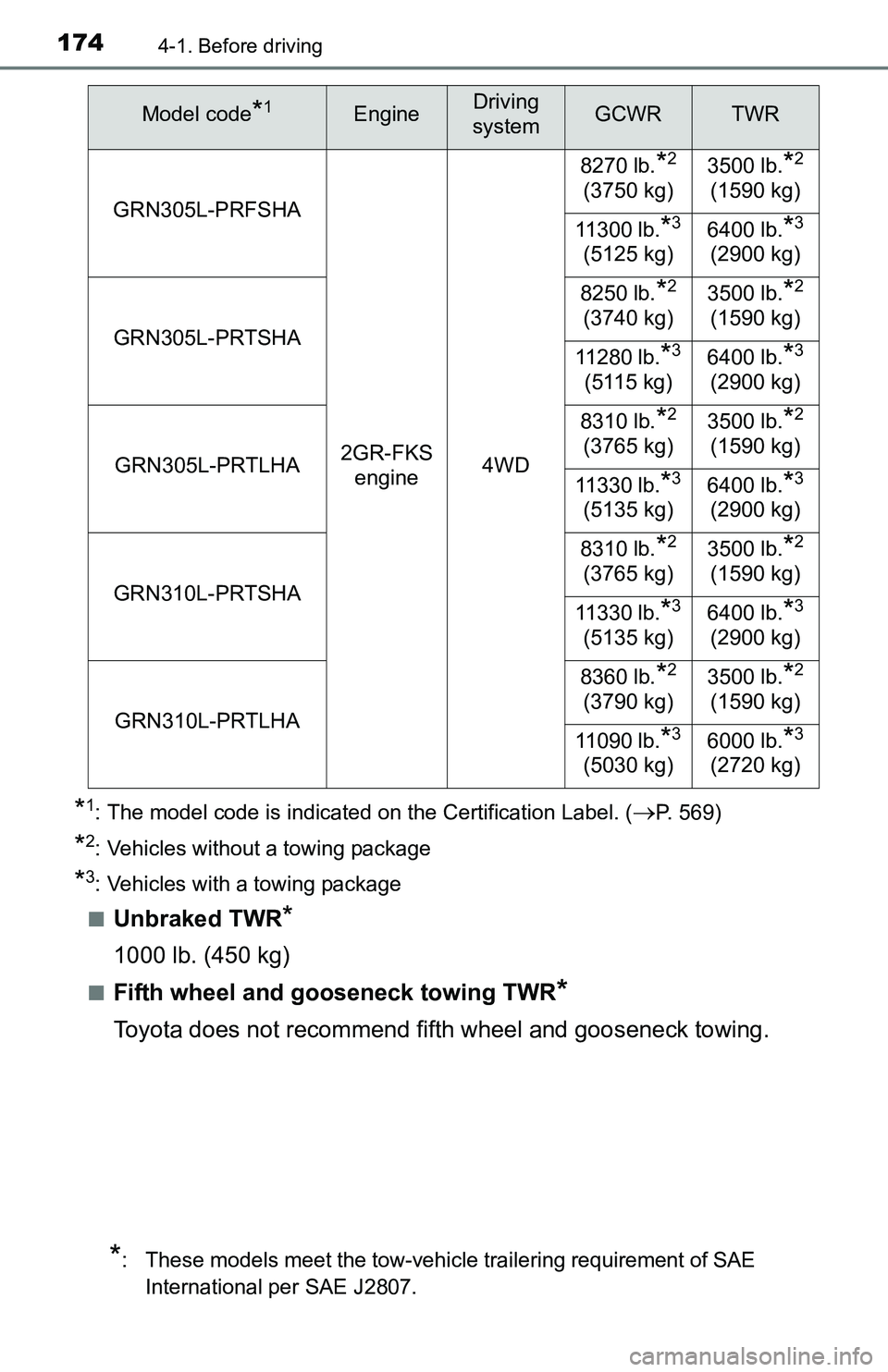
1744-1. Before driving
*1: The model code is indicated on the Certification Label. (P. 569)
*2: Vehicles without a towing package
*3: Vehicles with a towing package
■
Unbraked TWR*
1000 lb. (450 kg)
■Fifth wheel and gooseneck towing TWR*
Toyota does not recommend fifth wheel and gooseneck towing.
Model code*1EngineDriving
systemGCWRTWR
GRN305L-PRFSHA
2GR-FKS
engine4WD8270 lb.
*2
(3750 kg)3500 lb.
*2
(1590 kg)
11300 lb.
*3
(5125 kg)6400 lb.
*3
(2900 kg)
GRN305L-PRTSHA8250 lb.
*2
(3740 kg)3500 lb.
*2
(1590 kg)
11280 lb.
*3
(5115 kg)6400 lb.
*3
(2900 kg)
GRN305L-PRTLHA8310 lb.
*2
(3765 kg)3500 lb.
*2
(1590 kg)
11330 lb.
*3
(5135 kg)6400 lb.
*3
(2900 kg)
GRN310L-PRTSHA8310 lb.
*2
(3765 kg)3500 lb.
*2
(1590 kg)
11330 lb.
*3
(5135 kg)6400 lb.
*3
(2900 kg)
GRN310L-PRTLHA8360 lb.
*2
(3790 kg)3500 lb.
*2
(1590 kg)
11090 lb.
*3
(5030 kg)6000 lb.
*3
(2720 kg)
*: These models meet the tow-vehicle trailering requirement of SAE
International per SAE J2807.
Page 175 of 640
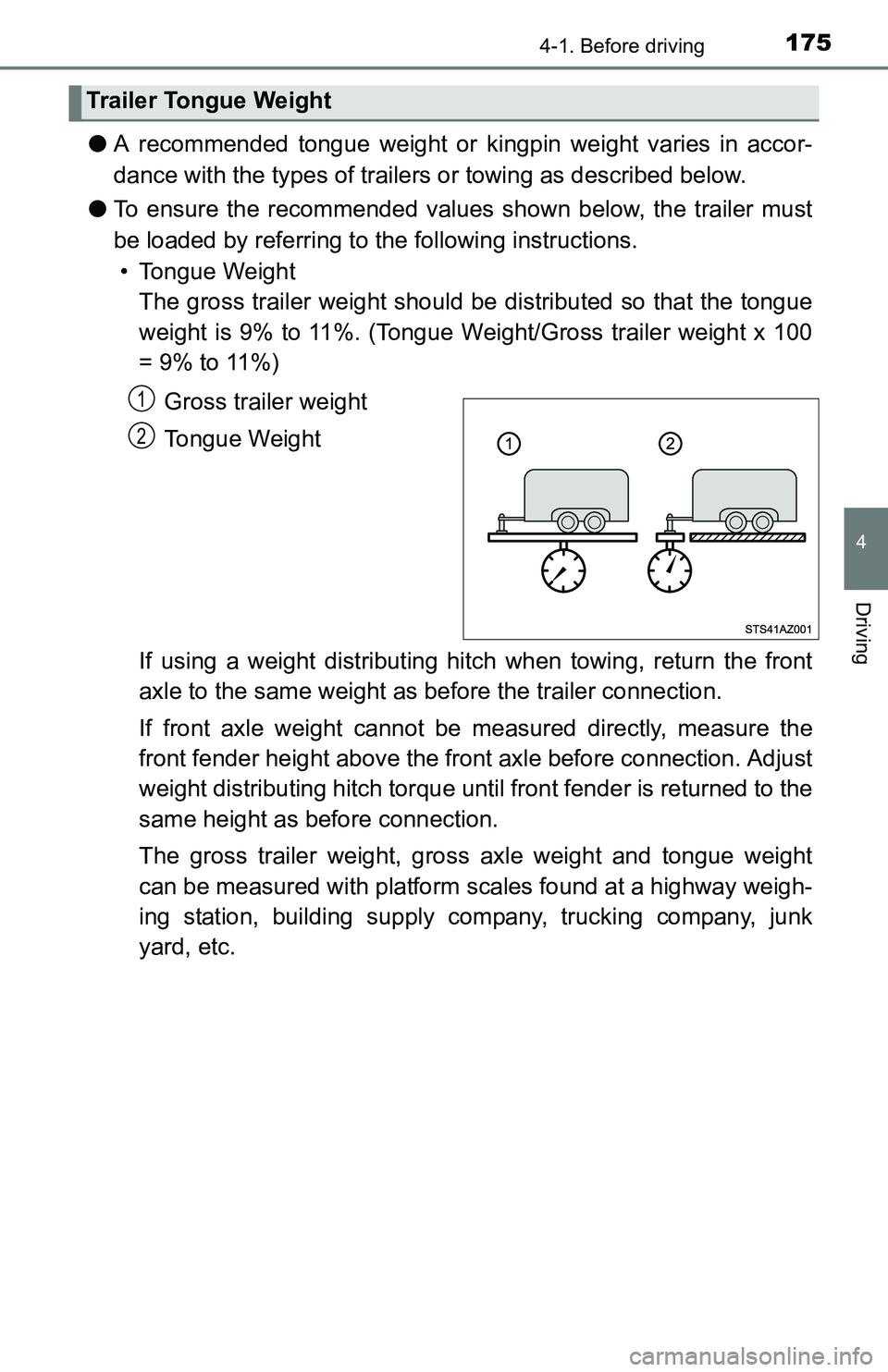
1754-1. Before driving
4
Driving
●A recommended tongue weight or kingpin weight varies in accor-
dance with the types of trailers or towing as described below.
●To ensure the recommended values shown below, the trailer must
be loaded by referring to the following instructions.
• Tongue Weight
The gross trailer weight should be distributed so that the tongue
weight is 9% to 11%. (Tongue Weight/Gross trailer weight x 100
= 9% to 11%)
Gross trailer weight
Tongue Weight
If using a weight distributing hitch when towing, return the front
axle to the same weight as before the trailer connection.
If front axle weight cannot be measured directly, measure the
front fender height above the front axle before connection. Adjust
weight distributing hitch torque until front fender is returned to the
same height as before connection.
The gross trailer weight, gross axle weight and tongue weight
can be measured with platform scales found at a highway weigh-
ing station, building supply company, trucking company, junk
yard, etc.
Trailer Tongue Weight
1
2
Page 176 of 640
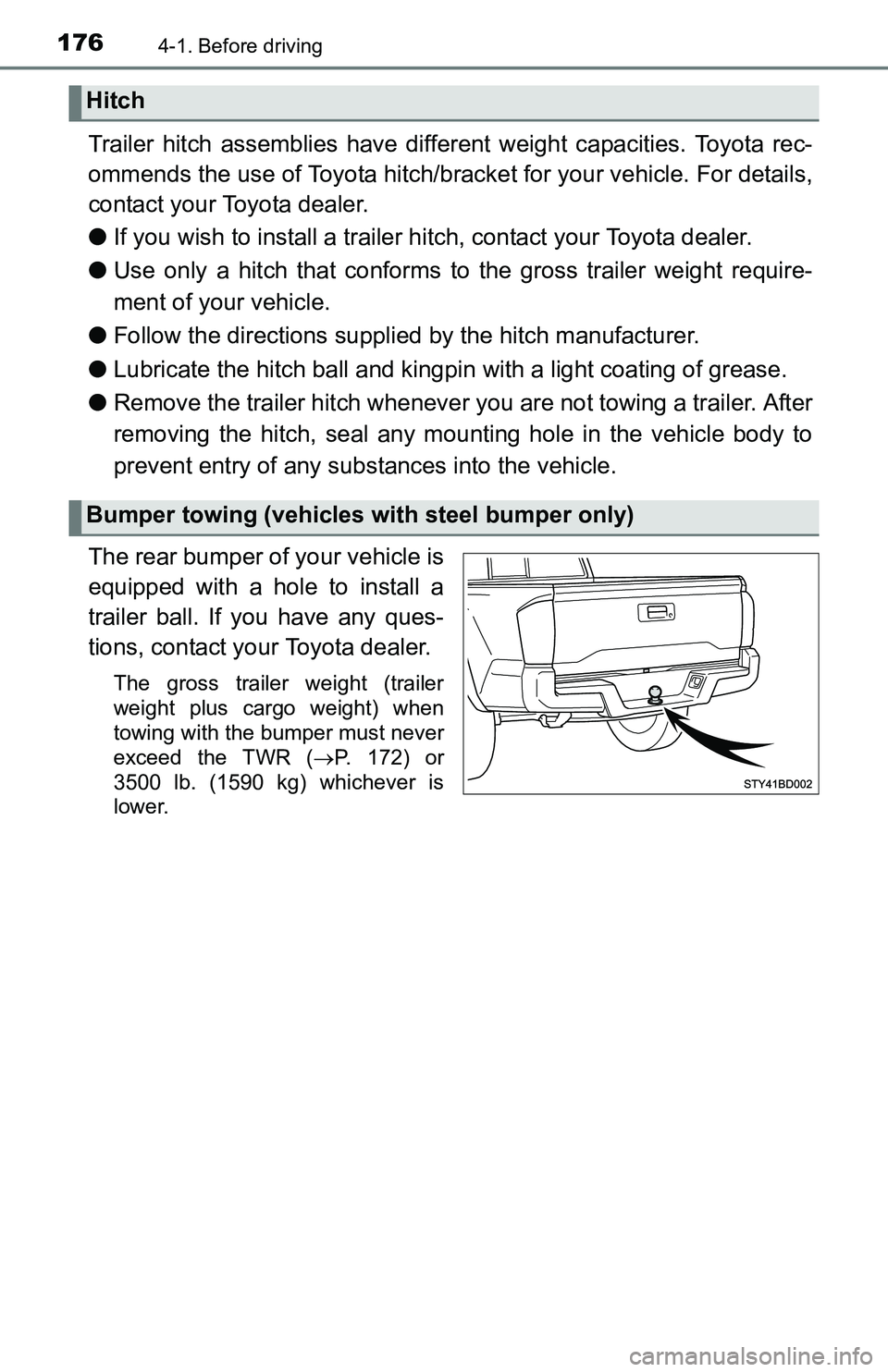
1764-1. Before driving
Trailer hitch assemblies have different weight capacities. Toyota rec-
ommends the use of Toyota hitch/bracket for your vehicle. For details,
contact your Toyota dealer.
●If you wish to install a trailer hitch, contact your Toyota dealer.
●Use only a hitch that conforms to the gross trailer weight require-
ment of your vehicle.
●Follow the directions supplied by the hitch manufacturer.
●Lubricate the hitch ball and kingpin with a light coating of grease.
●Remove the trailer hitch whenever you are not towing a trailer. After
removing the hitch, seal any mounting hole in the vehicle body to
prevent entry of any substances into the vehicle.
The rear bumper of your vehicle is
equipped with a hole to install a
trailer ball. If you have any ques-
tions, contact your Toyota dealer.
The gross trailer weight (trailer
weight plus cargo weight) when
towing with the bumper must never
exceed the TWR (P. 172) or
3500 lb. (1590 kg) whichever is
lower.
Hitch
Bumper towing (vehicles with steel bumper only)
Page 177 of 640
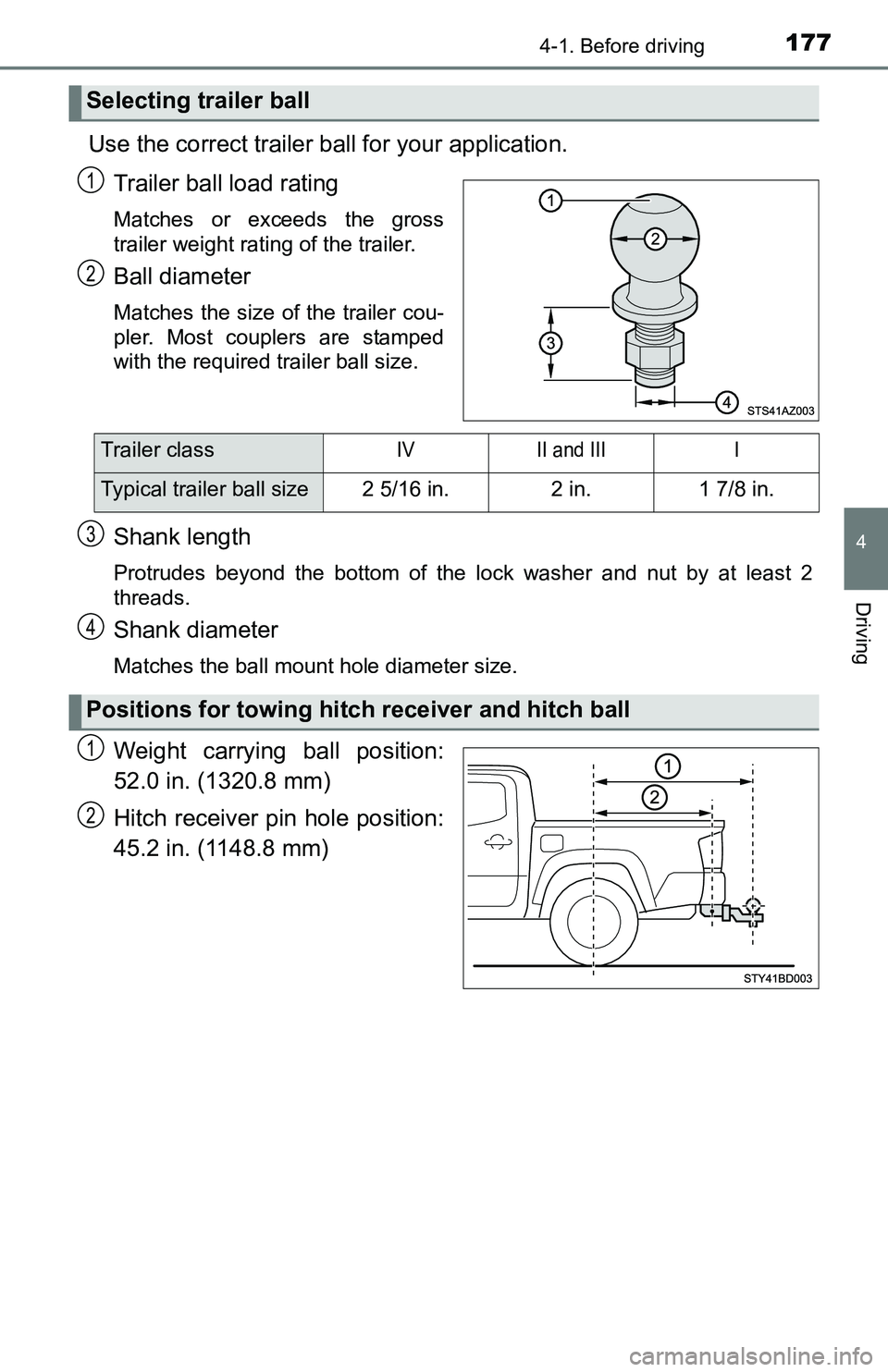
1774-1. Before driving
4
Driving
Use the correct trailer ball for your application.
Trailer ball load rating
Matches or exceeds the gross
trailer weight rating of the trailer.
Ball diameter
Matches the size of the trailer cou-
pler. Most couplers are stamped
with the required trailer ball size.
Shank length
Protrudes beyond the bottom of the lock washer and nut by at least 2
threads.
Shank diameter
Matches the ball mount hole diameter size.
Weight carrying ball position:
52.0 in. (1320.8 mm)
Hitch receiver pin hole position:
45.2 in. (1148.8 mm)
Selecting trailer ball
1
2
Trailer classIVII and IIII
Typical trailer ball size2 5/16 in.2 in.1 7/8 in.
Positions for towing hitch receiver and hitch ball
3
4
1
2
Page 178 of 640
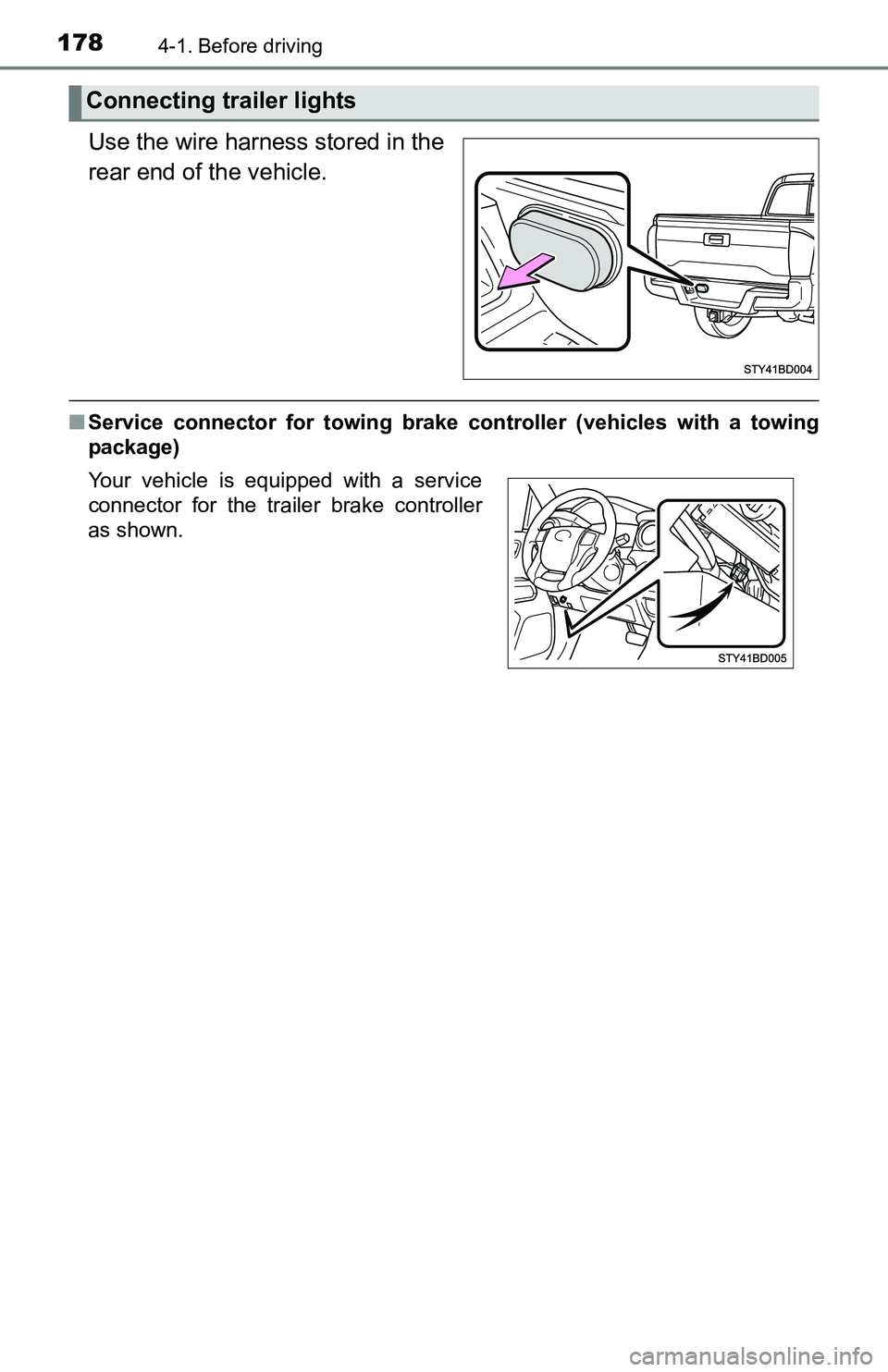
1784-1. Before driving
Use the wire harness stored in the
rear end of the vehicle.
■Service connector for towing brake controller (vehicles with a towing
package)
Connecting trailer lights
Your vehicle is equipped with a service
connector for the trailer brake controller
as shown.
Page 179 of 640

1794-1. Before driving
4
Driving
Your vehicle will handle differently when towing a trailer. To help avoid
an accident, death or serious injury, keep the following in mind when
towing:
●Speed limits for towing a trailer vary by state or province. Do not
exceed the posted towing speed limit.
●Toyota recommends that the vehicle-trailer speed limit is 65 mph
(104 km/h) on a flat, straight, dry road. Do not exceed this limit, the
posted towing speed limit or the speed limit for your trailer as set
forth in your trailer owner’s manual, whichever is lowest. Instability
of the towing vehicle-trailer combination (trailer sway) increases as
speed increases. Exceeding speed limits may cause loss of control.
●Before starting out, check the trailer lights, tires and the vehicle-
trailer connections. Recheck after driving a short distance.
●Practice turning, stopping and reversing with the trailer attached in
an area away from traffic until you become accustomed to the feel
of the vehicle-trailer combination.
●Reversing with a trailer attached is difficult and requires practice.
Grip the bottom of the steering wheel and move your hand to the
left to move the trailer to the left. Move your hand to the right to
move the trailer to the right. (This is generally opposite to reversing
without a trailer attached.) Avoid sharp or prolonged turning. Have
someone guide you when reversing to reduce the risk of an acci-
dent.
●As stopping distance is increased when towing a trailer, vehicle-to-
vehicle distance should be increased. For each 10 mph (16 km/h)
of speed, allow at least one vehicle and trailer length.
●Avoid sudden braking as you may skid, resulting in the trailer jack-
knifing and a loss of vehicle control. This is especially true on wet or
slippery surfaces.
●Avoid jerky starts or sudden acceleration.
●Avoid jerky steering and sharp turns, and slow down before making
a turn.
●Note that when making a turn, the trailer wheels will be closer than
the vehicle wheels to the inside of the turn. Compensate by making
a wider than normal turning radius.
Trailer towing tips
Page 180 of 640
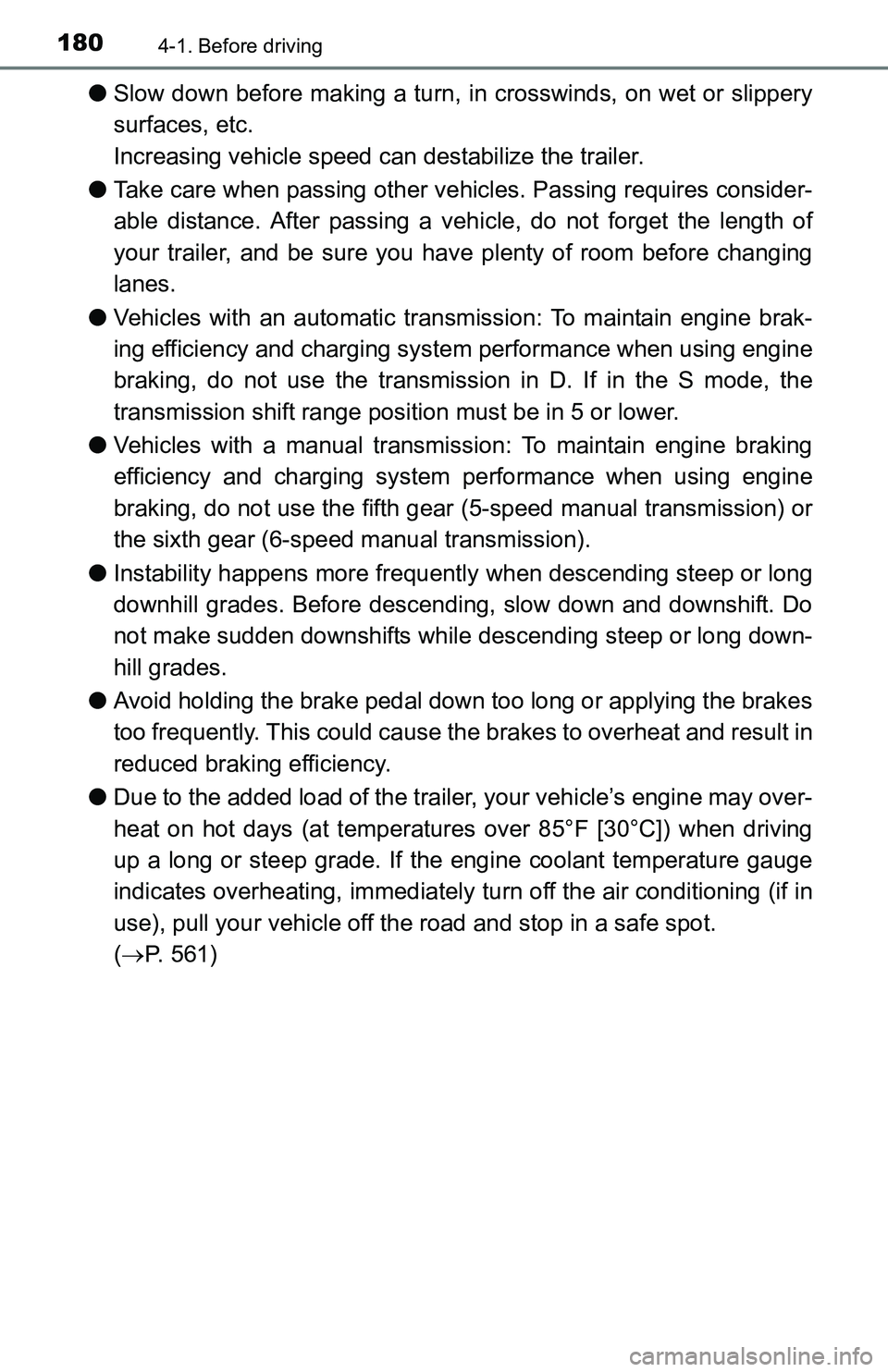
1804-1. Before driving
●Slow down before making a turn, in crosswinds, on wet or slippery
surfaces, etc.
Increasing vehicle speed can destabilize the trailer.
●Take care when passing other vehicles. Passing requires consider-
able distance. After passing a vehicle, do not forget the length of
your trailer, and be sure you have plenty of room before changing
lanes.
●Vehicles with an automatic transmission: To maintain engine brak-
ing efficiency and charging system performance when using engine
braking, do not use the transmission in D. If in the S mode, the
transmission shift range position must be in 5 or lower.
●Vehicles with a manual transmission: To maintain engine braking
efficiency and charging system performance when using engine
braking, do not use the fifth gear (5-speed manual transmission) or
the sixth gear (6-speed manual transmission).
●Instability happens more frequently when descending steep or long
downhill grades. Before descending, slow down and downshift. Do
not make sudden downshifts while descending steep or long down-
hill grades.
●Avoid holding the brake pedal down too long or applying the brakes
too frequently. This could cause the brakes to overheat and result in
reduced braking efficiency.
●Due to the added load of the trailer, your vehicle’s engine may over-
heat on hot days (at temperatures over 85°F [30°C]) when driving
up a long or steep grade. If the engine coolant temperature gauge
indicates overheating, immediately turn off the air conditioning (if in
use), pull your vehicle off the road and stop in a safe spot.
(P. 561)